Virtual waves: Textile arts on Facebook by Carol Naylor
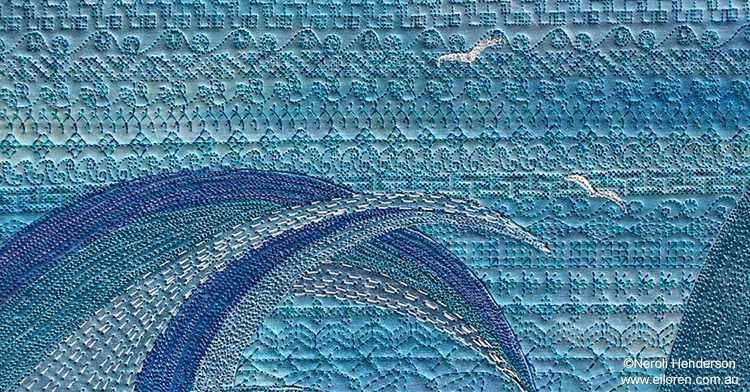
Carol Naylor is a contemporary textile artist specialising in machine embroidery. She creates unique, one off textiles by stitching directly onto canvas using a variety of rayon, cotton, woollen and metallic threads. Her stitched textiles range from small intimate pieces to large scale hangings.
Carol’s work has been shown in many group and solo exhibitions and she teaches and exhibits in the UK and abroad. As well as exhibitions and work for galleries and private venues her work has been commissioned and collected by public, corporate and private clients.
This guest post was contributed by Carol Naylor. You can view her other contributions to TextileArtist.org here:
- Making art to commission by Carol Naylor
- Applying & submitting art to galleries: Carol Naylor
- Carol Naylor interview: The best second best
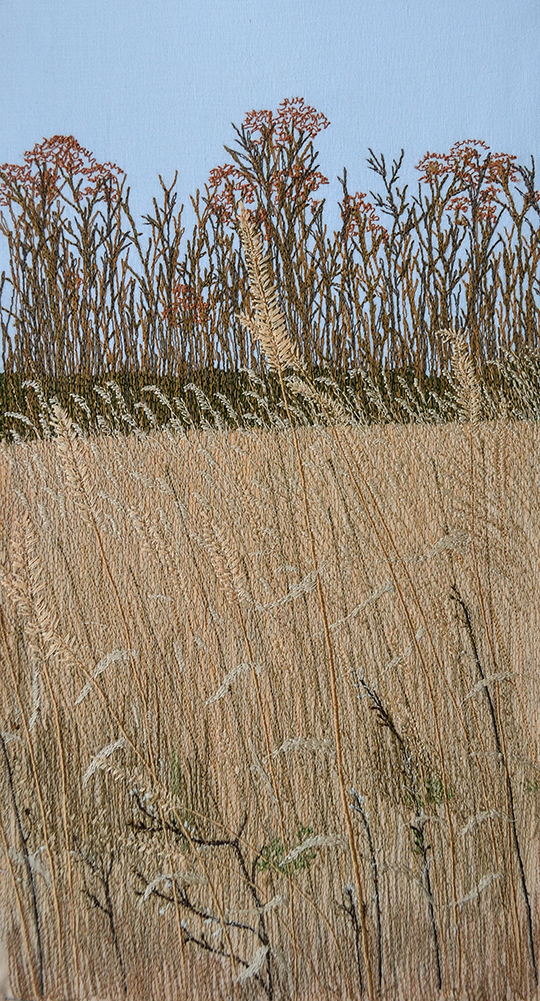
Judi Miller, “Fall Grass“ 2014, 17.5cm x 35cm White cotton with fabric paint and free motion embroidery
Judi Miller, Canada – www.judimiller.ca
Judi works from her own photos using her travels and the local landscape in Kanata, Ontario, Canada as her inspiration. She paints the background on white cotton using fabric paint (Pebeo – Setasilk) and adds free motion machine embroidery for all the detail.
She has been sewing for as long as she can remember, but began free motion embroidery in earnest, in the early 1990s, when she left the Canadian Conservation Institute, where she had worked as an analytical chemist.
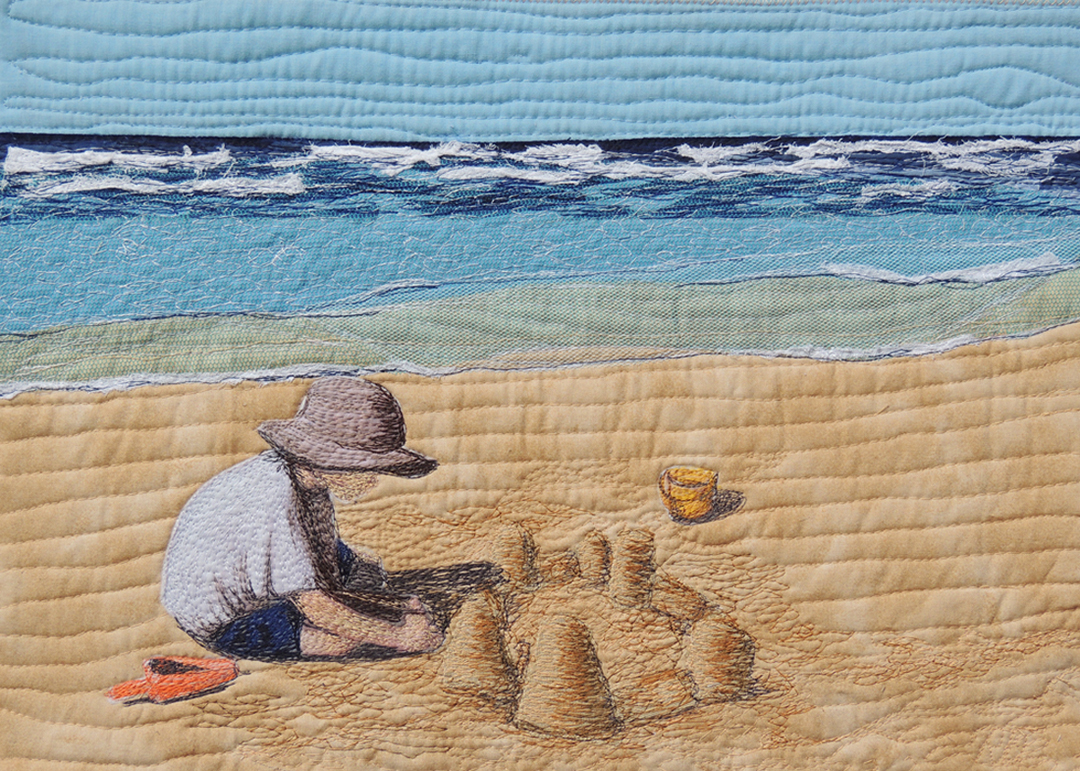
Rebekah Dundon, “Cam’s Castle” 2014. 45 x 32 cm. Free machine stitching over layered fabrics, based on a photo of her son creating one of his many sandcastles.
Rebekah Dundon, Australia – www.bekahdu.com.au
Rebekah has a long history of cross -stitch and general sewing, starting to cross- stitch when she was about 4 years old, and stitching up until her teenage years. She studied Studio Textiles at Melbourne College of Textiles, but stopped making textiles for some 15 years, moving on to study sculpture and ceramics as well as working on paintings. Rebekah started creating Textile Art again about 4 years ago, falling in love with the possibilities of free motion quilting.
Virtual waves: Textile arts on Facebook
We know we live in an expanding universe, but how many of us could ever have imagined twenty years ago how the expanding virtual world would change our everyday lives, affecting the way we communicate and work, giving us instant availability of information, good and bad, and of course the extraordinary rise in the use of social media.
Facebook is perhaps the best known, and at times the most controversial. Write something, upload an image, press a button, and it’s out there in a millisecond, seen by potentially thousands of people, both known and unknown to the sender.
When I started my own personal page back in 2009, I saw it as simply an easy way of keeping in touch with friends and family but gradually as I showed images of my own work, I began to make new contacts, reach different audiences, and I discovered a way of sharing ideas and experiences.
In early 2014, I saw a link to a page called Textile Arts. I had already begun to use other similar sounding pages, but this one was intriguing. Whereas many other pages showed commercial work, had irritating ads spread down the wall, or were used purely by many members for blatant self-promotion and selling, this page was refreshingly clean. I joined, put up an image, and got an immediate, positive response. Here were artists who worked in all types of textile media, professionals, beginners, and people of all ages worldwide, who celebrated and shared my passion for the world of textiles.
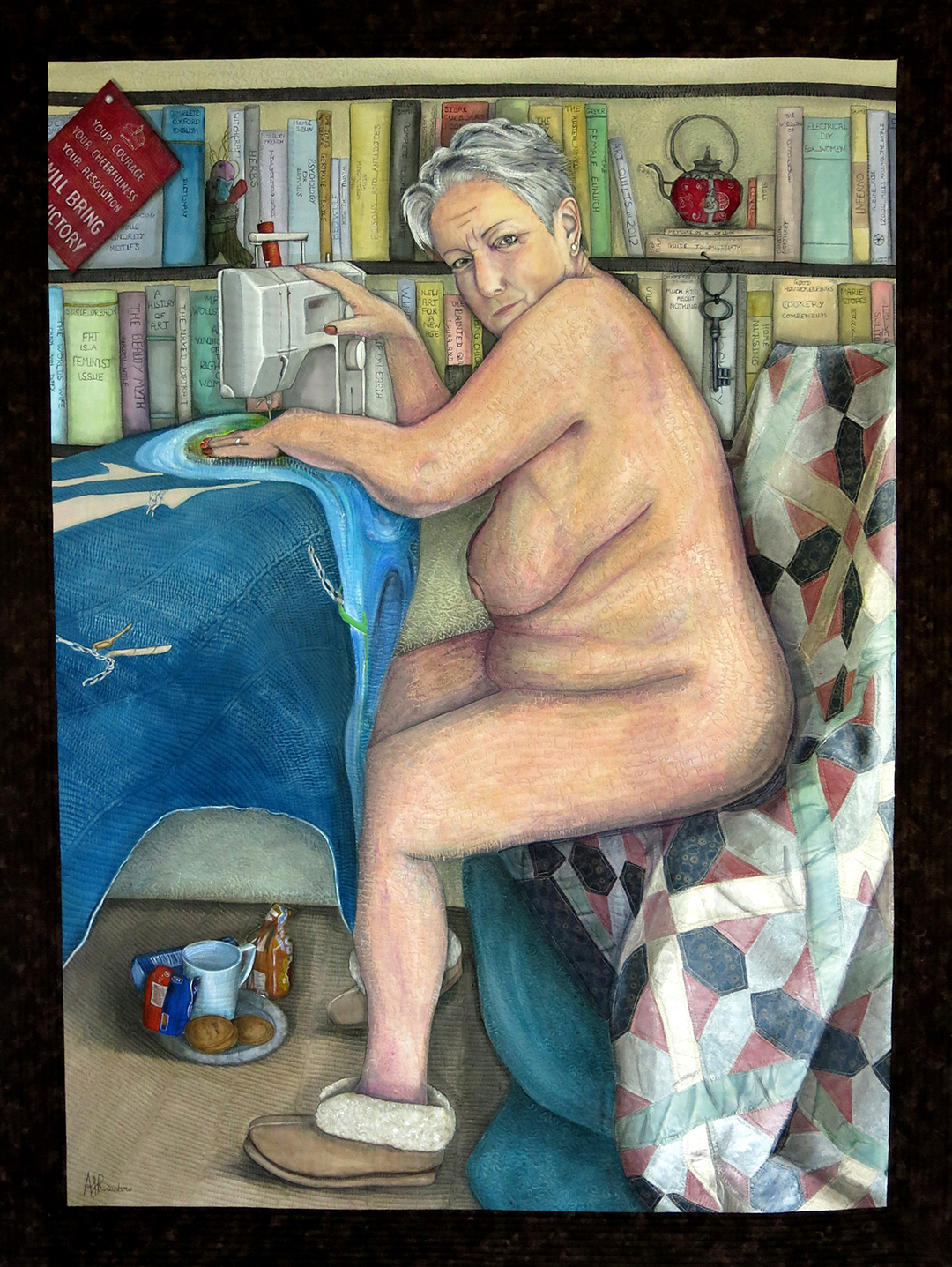
Annabel Rainbow, Life 4 – “Hello Dear, What Did You Do Today?” 2012. 57″ x 42″. Painted quilt: English piecing over papers (quilt draped on chair) applique, stitch, acrylic paint.
Annabel Rainbow, UK – www.annabelrainbow.co.uk – www.throughourhands.co.uk
Annabel’s work is about the prejudices we encounter on a daily basis, and each tells a story graphically and in text, stitched onto the naked body of the woman portrayed. The text is often in stark contrast to the cosy domestic imagery. Why naked? Her wish is to take away all the assumptions and prejudices that clothes bring and look at the human being underneath in its true and natural state. She began to sew about 12 years ago and then studied the basics of painting and drawing, including life studies.
These skills have merged into the “Life Story” series of painted quilts, and this is number 4.
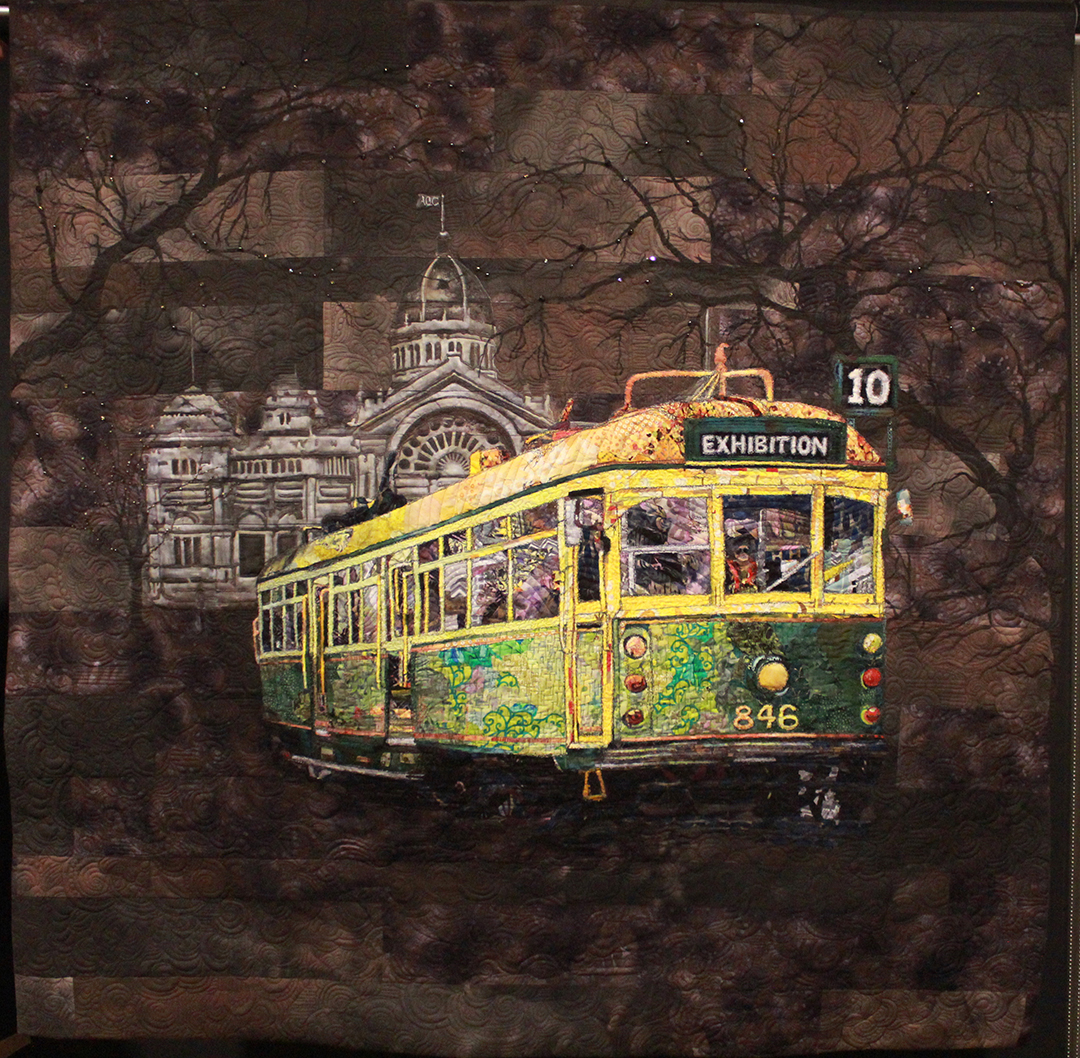
Sue De Vanny, “Tram Route no 10, Full” 2014. 125cm square. Commercial and hand painted pieced fabric with fabric collage, additional painting, thread sketching, quilting and beading
Sue De Vanny, Australia – www.facebook.com/inbarefeetSuedeV
The inspiration for this quilt was from the Australasian Quilt Convention celebrating its tenth year in Melbourne, Australia, in 2014. The iconic tram route no 10, with the famous Royal Exhibition Buildings also feature in her composition. Inspired by her mother, a seamstress, who also made clothes for her family, textiles and sewing have always been a part of Sue’s life. She has no formal art training but cannot remember a time when she didn’t have a pencil or brush in her hand, which has fed her love of textiles. She usually works in bare feet!
UK quilt artist Annabel Rainbow started the page in 2010. First named Quilts in Art Galleries, she then later changed it to the more all-embracing Textile Arts.
She says,
I’ve always felt that there are some quilts, made by astounding artists, which deserve to be lifted out of the arena of the craft of quilting, and shown in the Fine Art world alongside paintings, sculpture, installations etc.
In 2010, the V&A held a quilt exhibition. They were astonished at how many people came to visit the quilts on show, flying in from around the globe and filling all the local hotels. I wasn’t, but still found difficulty persuading local art galleries to hold art exhibitions featuring only quilts and I was determined to try to do something about it. One of the first things I did was to start this page, with the sole aim of bringing together quilters and those interested in textiles. The group grew and grew, and was instrumental in my being able to organize the first Through Our Hands exhibition at Leamington Spa Art Gallery and Museum in 2012/13.
During 2011, Annabel handed ownership of the group over to Australian quilt artist, Neroli Henderson, who continued to build upon the initial success of the page. At that point, the group had about 200 members. Her energy and commitment took the membership to 1000 by July 2013, achieved by constantly promoting the site, asking artists about their work, and posting regularly, and was, she says, hard work!
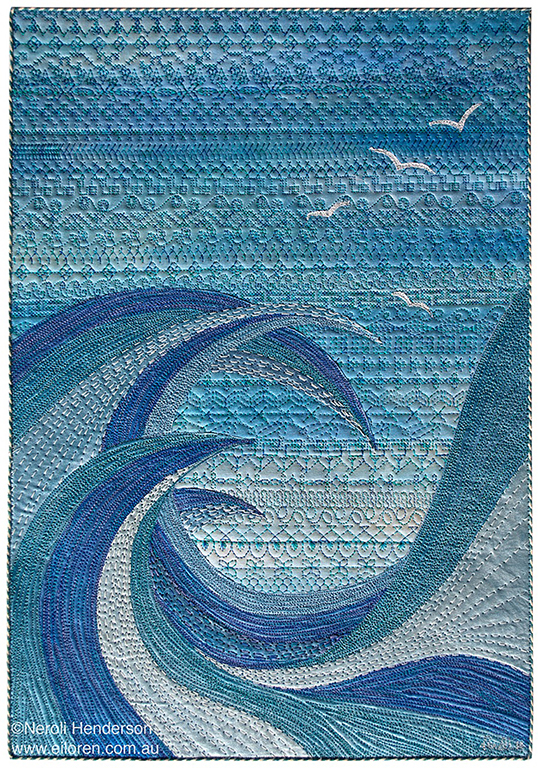
Neroli Henderson, ‘The Churning’ 2014. 42cm x 29.7cm. Luminescent and metallic paint, raw edge appliqué, stitch, couched cord.
Neroli Henderson, Australia – www.eiloren.com.au
This quilt was made for the monochromatic challenge on the “Art Quilts Around the World” blog group. Neroli chose to work in a blue tonal range, and intended to make something very abstract. As she developed her ideas through drawings of curved lines and swirls, the forms began to resemble water and waves, which metamorphosed into the churning sea.
Coming from an art direction / graphic design background, she focused primarily on fine art after a bad back fracture necessitated a change. Her work, whilst beautiful, often focuses on introspection and melancholia.
As the membership grew, Neroli added two more admins to help her manage the page, and then in May 2014, with numbers reaching 3000, she put out a call for more help from the worldwide membership. That is when I volunteered.
It has proved a really fascinating and worthwhile experience. There are currently 11 admins based in Australia, the UK, Denmark, the USA, and Canada, which means that we cover a very wide range of time zones between us although it is easy to forget that the person you are talking to really wants to go to bed when you have just had breakfast. Moreover, it has certainly been a huge learning curve for me regarding the machinations of Facebook!
What makes this group stand out from all the hundreds of others, and why is the growth so impressive? At the time of writing, we are fast approaching 10,000 members and show no sign of slowing down. Perhaps the following gives some idea of how we try to maintain the page with an ever increasing membership.
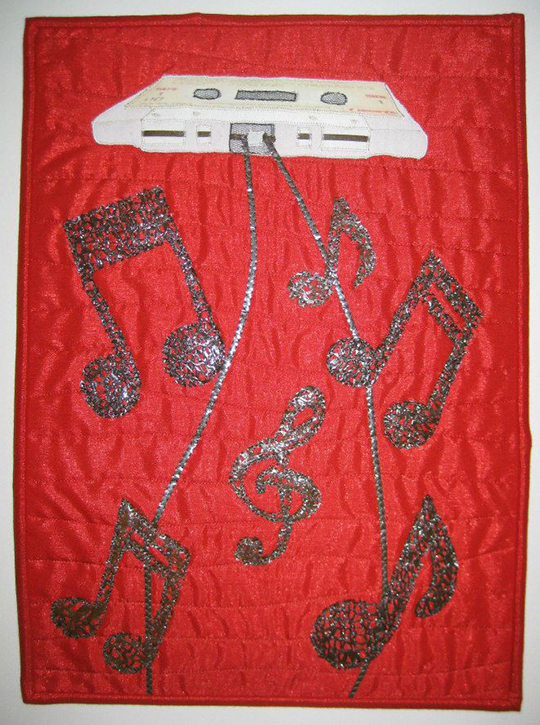
Ann Halden, “Where has All the Music Gone” 2014. Knitted cassette tape sewn onto a fabric background.
Ann Halden Australia – www.facebook.com/ann.halden.9
After doing traditional patchwork for many years, Ann found she needed more of a challenge, so she began to work in other textile media, which led to the making of art quilts. She loves the diversity that the different techniques offer, and thoroughly enjoys creating her pieces, exploring the vast array of materials & textiles now available, and inventing and adding to these.
Ann created this piece for the “One Step Further” exhibition held in Box Hill, Victoria, Australia
Sham Abu Bakar, Malaysia – fifabart[at]yahoo.com
Sham Abu Bakar holds a Master Degree in textile design from the University Institute of Technology of MARA.
He makes exquisite contemporary batiks that use traditional methods, many on a large scale, and runs a batik workshop that does commissioned work for local designers in Malaysia.
He lectures part time in local art colleges, curates exhibitions, and plays an active role in the local art scene, exhibiting his work, and giving workshops and talks.
We have rules, not easy to implement at times, but they are there to guide not only the members but ourselves as well. Written in English, French, Spanish, and Japanese, I have yet to find any other groups who provide this facility!
We have a mission statement, which echoes Annabel’s original intentions.
This group is for people making art that has a clear textile component. We are not judgmental, though subjectivity can at times make decisions difficult, but we try to show work that could be seen in a gallery context, at the same time acknowledging that what one gallery might show, another would not.
This means that we had to make hard choices as the group grew, and now no longer include items like every day wearables, toys, dolls, anything mass -produced or commercial, as many other groups exist for these. It is not our role to critique work, but we do seek to encourage all those who ask for help.
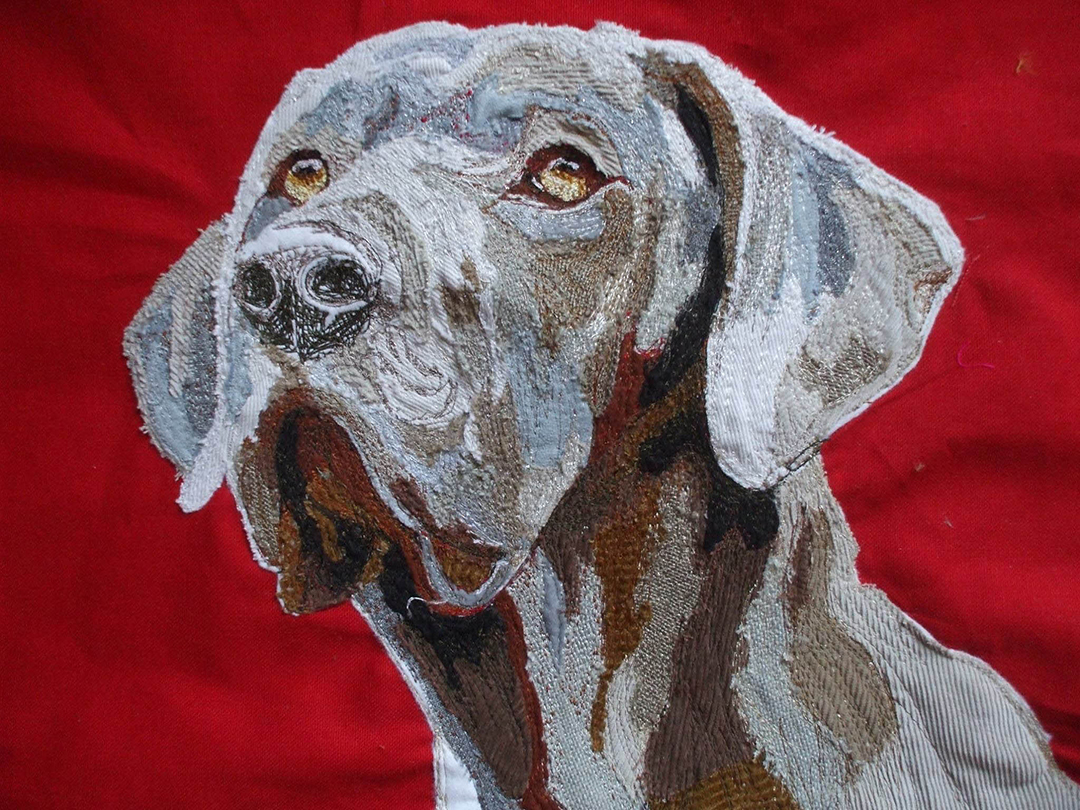
Chrissie Davies, “Arlo, the pointer” 2014. 45cm x45cm. Free form machine embroidery and fabric collage.
Chrissie Davies UK – www.chrissiedavies.com
A creative light came on for Chrissie when she first sat at a sewing machine during her Arts degree at Chichester University 20 years ago. She now works to commission making animal portraits, drawing out each one and using a jigsaw of fabric fragments with machine embroidery. At the heart of her portraits is a love of detail and a passion for expressive colour. The dynamics of the juxtaposition of stitch and the intricate weft and weave of fabrics, create exciting textures, with the stitched line providing boldness and permanence.
We also limit members to one post a week, with a detail of the work if wished. This stops enthusiasts from flooding the wall with their own work, and ensures that the page remains fresh and lively.
Members can also post links to exhibitions, workshops, opportunities, and their studios, providing there is a textile image on the post.
The admins communicate with one another regularly and if one of us has a query, we discuss it fully, before taking any action. We always send a message to anyone whose post we have removed explaining our reasons. This is difficult, and we do not enjoy doing it, but mostly we get lovely responses back. We ban those who spam, or use the site for self-aggrandisement or direct selling.
Our members come from the four corners of the globe. Europe, the Americas, Australasia, Asia, Africa. We see work influenced by ethnic backgrounds with a contemporary twist, hand sewing, machine embroidery, quilts that take your breath away, batik, dyeing, printing, weaving, sculptural works, collages, diverse elements combined together. There is no end to people’s imagination and not enough space to explain it all!
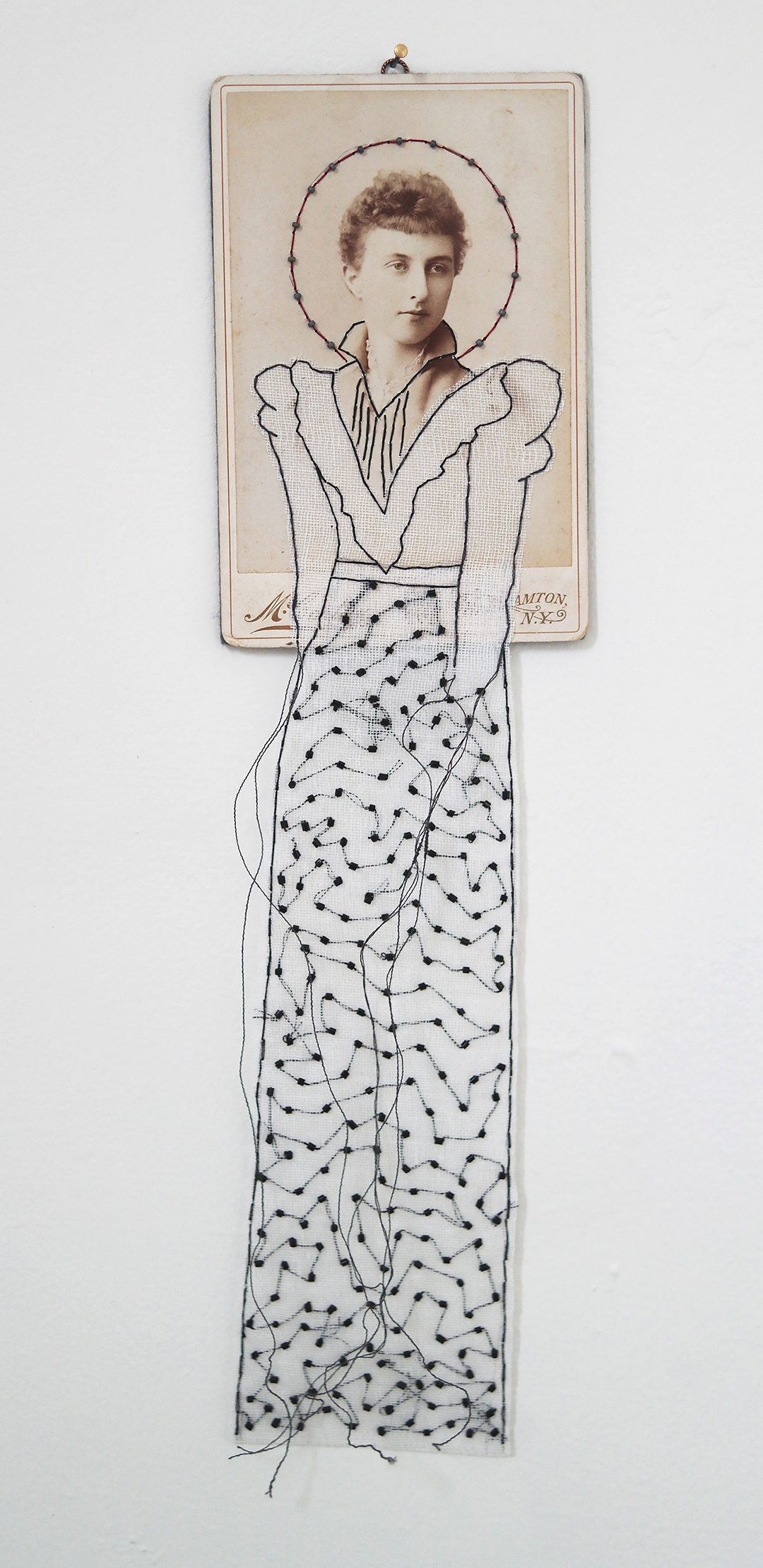
Cindy Steiler, “Forgotten no. 70” 2014. 11.25cm x 37.5cm. Hand embroidered 19th century cabinet card photo with a beaded starched gauze dress.
Cindy Steiler USA – www.cindysteiler.com
The series “Forgotten” is a collection of 19th Century cabinet card photographs of unidentified female subjects. Their bodies and clothing have been hand-embroidered using threads made from both natural fibres and metal, breathing new life into these forgotten women.
Cindy studied set and costume design at Colorado State University. Combining her education with needlework skills taught to her by her great grandmother Mary Steiler, her love for textile art was born. She draws with thread.
We make contacts and friends too, and the outreach is amazing. Someone who had seen my work in the USA recognised it and commented on it. A UK based member, originally from Portugal, had also seen, and been influenced by, earlier exhibitions I had held there and we have since met up.
Members ask questions, need advice, are curious about techniques. All these elicit responses, and can be so encouraging, not just to the questioner, but for the artist concerned too.
Emilio Longhi Caceres, Peru – www.facebook.com/emiliolonghic
Emilio Longhi is a Peruvian sculptor who incorporates textile techniques in his work, weaving and twisting wire, threads, and cable into his stunningly unusual sculptural forms. He lives and works in Lima and has won several national awards.
The human body, animals, and the theatre provide some of the inspirations for his work, with the themes of relationships and the place of women in a patriarchal and macho Peruvian society very much in evidence in some of his sculptures.
Why not then look at what is happening? You might already know us, or if not you might decide to join. Many members simply enjoy looking at what is on show, whilst others make regular contributions. This article shows just a few examples of our members’ work. Look at the page and you will see a wealth of images and ideas.
Some of us trained in either Fine Art or Textiles, whilst others learned skills from their parents and grandparents, or made work using traditional techniques like patchwork or knitting, which they have developed and extended.
Whatever you decide, no two days are ever the same, and you will see wonderful colour, imaginative use of materials and threads, images that are gently naïve, images that are making a statement, work that reflects a lifetime of making, or work from someone who has just begun to engage in the fabulous, magical world of textile arts.
Carol Naylor is a UK textile artist, you can find more information on her at www.carolnaylor.co.uk or www.carolnaylortextiles.com
You can see more work by all the artists featured in this article and many more on our Facebook page: www.facebook.com/group/textilearts
Want to let others known about the Textile Arts group? Share this guest post on Facebook.

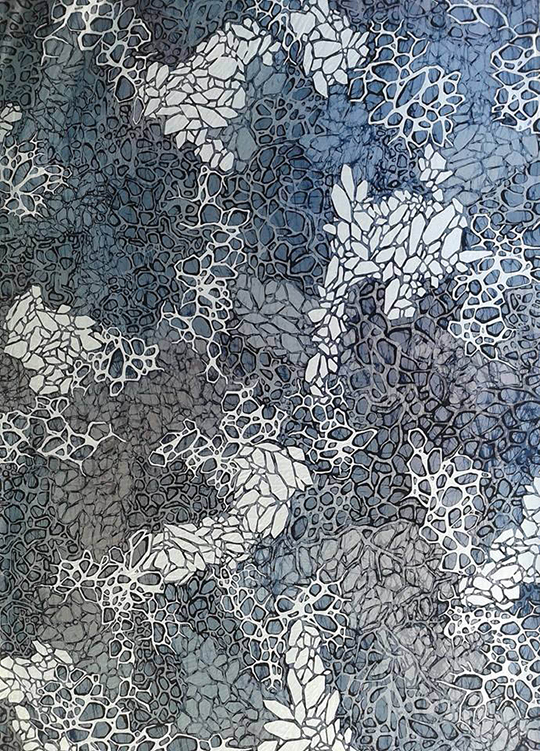
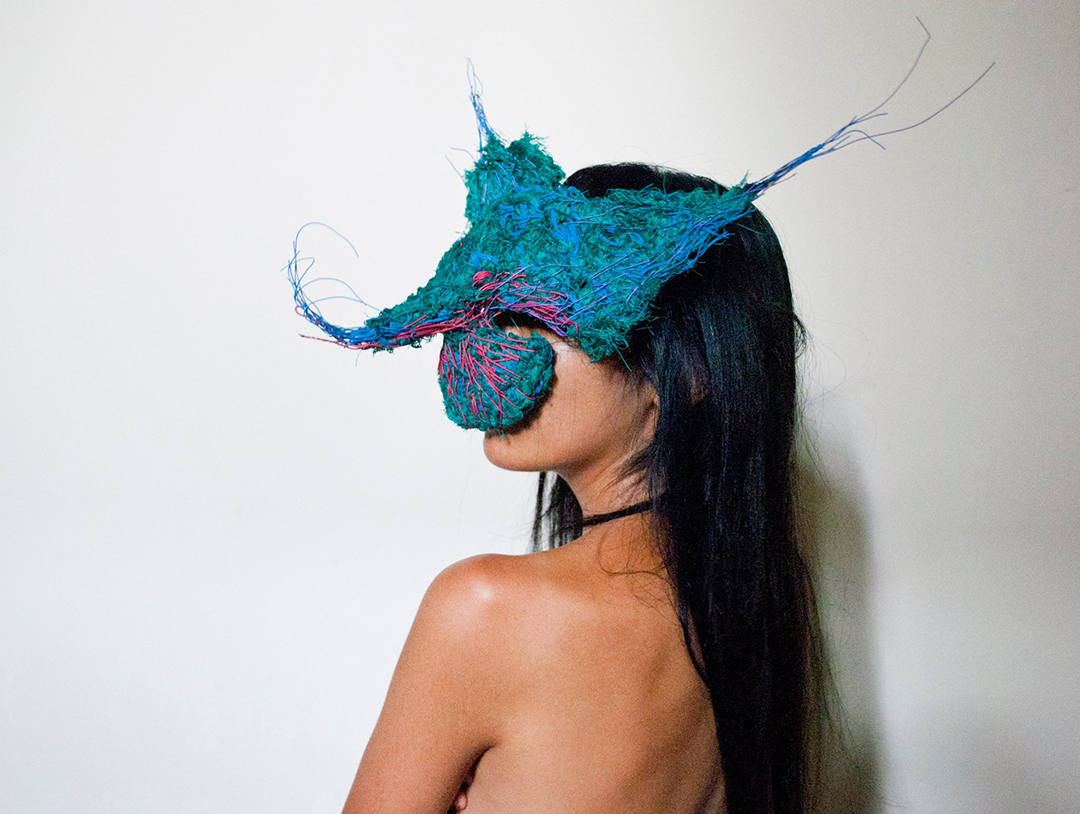















alas, the links to the FB page do not work
Interesting! I didn’t realize that there were so many of you working behind the scenes to keep this group going. I get notifications from my friends who post there and check it from time to time and it truly is wonderful to see all of the talent shown there. We live in such an amazing time where all of the arts are flourishing, crossing boundaries, exploring new concepts, and merging into each other… even at a time when so many artists also struggle financially as galleries and funding close or dry up.
Facebook has been TAFA’s main referrer ever since we launched five years ago. I think that those of us who are invested there have a hate/love relationship with it as it constantly changes and seeks to monetize the site. I’ve tried many other platforms, but Facebook has all of the tools we need in order to show work, have discussions, and network. I think they were brilliant in setting up the personal, business and group formats and having the ability to make them private or public. But, it’s a challenge to keep up with the changes and to try to help people make the most of their presence there.
I wrote a post about the basics a while ago and probably need to write a second one with tips that I have found useful. Here is the original post: http://www.tafalist.com/facebook-for-artists/
The main thing I would encourage our textile artists to do is to set up a separate business page for their art. There are different tools for personal and business pages, but the main reason is that if they are serious about developing a following and want to sell their work, they should not force interested parties to become “friends”. Some people do keep their personal pages for family and friends whom they actually know and might not want to engage in that way with people they may admire on a professional basis.
The one thing that is frustrating about groups like Textile Arts or the others I belong to is that Facebook does not allow you to use your business identity to post. That would make it so much easier to find our pages instead of having to look at the personal ones for information on the art.
Thanks for sharing your process and for all the good work you do for our community!
Hi Rachel,
You can share from your business page to groups, including to Textile Arts – and I do this with my Eiloren Art & Design by Neroli Henderson page frequently. You can also put a URL link to your website underneath the description of each piece.
We actually don’t want to have people posting purely with their business identities (if Facebook allowed this) as it personalises the art to have a name and not all business pages are the name of the artist. The group really is for individual artists to show their work and for galleries and magazines etc to have a nice wide pond to fish for new talent. We don’t allow any posts at all promoting an entire page, group or website either instead having a ‘promote the piece and not the site’ policy. We want it to be a place of inspiration rather than advertising.
https://www.facebook.com/groups/textilearts/
Try my website link to Textile Arts on Facebook
Thank you so much for the added information Textileartist.org! So much better <3
Delighted to see the responses to this article. It was so difficult selecting the work to show you from our huge and talented membership but this gives a glimpse of what is going on worldwide
I really enjoyed this article. The Facebook page ‘Textile Arts’ is a wonderful venue for textile artists in various stages of their careers, emerging through well established. The work that goes on behind the scenes to make this page a success is a task that requires dedication and a good sense of humour.
Thanks so much Judi. It was a real privilege to be able to use a piece of your work in it thank you
Great article Carol, it’s great being part of Textile Arts.
I met Neroli years ago at ATASDA, unfortunately I lost touch due to ill health. Back on track now and involved with a few artist’s groups on the Ballanrine Peninsula. Not too many textile artist down this way, so would love to reconnect.